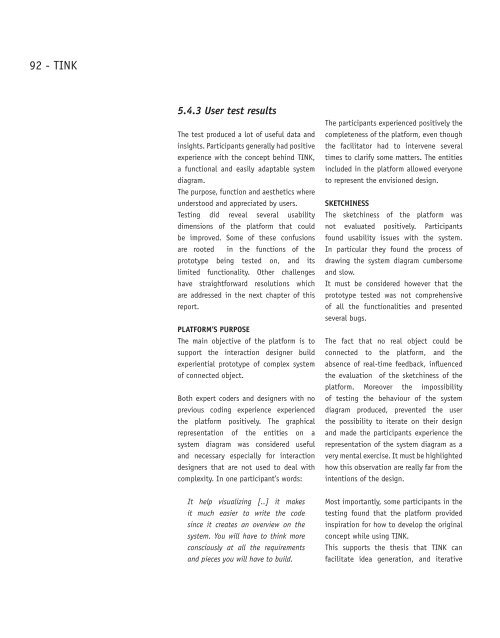TINK - sketching product experiences of connected objects
Tink is the result of my graduation project from the master in design for interaction at TUDelft. Tink is a web platform that connects products with one another via the Internet, it provides designers with a complete Internet of Things (IOT) development environment. Designers are provided with a rich stack of features to sketch, prototype and test IOT projects. Tink is a user-friendly, visual, collaborative, open-source tool for designers to build connected interactions among objects.
Tink is the result of my graduation project from the master in design for interaction at TUDelft.
Tink is a web platform that connects products with one another via the Internet, it provides designers with a complete Internet of Things (IOT) development environment.
Designers are provided with a rich stack of features to sketch, prototype and test IOT projects. Tink is a user-friendly, visual, collaborative, open-source tool for designers to build connected interactions among objects.
Create successful ePaper yourself
Turn your PDF publications into a flip-book with our unique Google optimized e-Paper software.
92 - <strong>TINK</strong><br />
5.4.3 User test results<br />
The test produced a lot <strong>of</strong> useful data and<br />
insights. Participants generally had positive<br />
experience with the concept behind <strong>TINK</strong>,<br />
a functional and easily adaptable system<br />
diagram.<br />
The purpose, function and aesthetics where<br />
understood and appreciated by users.<br />
Testing did reveal several usability<br />
dimensions <strong>of</strong> the platform that could<br />
be improved. Some <strong>of</strong> these confusions<br />
are rooted in the functions <strong>of</strong> the<br />
prototype being tested on, and its<br />
limited functionality. Other challenges<br />
have straightforward resolutions which<br />
are addressed in the next chapter <strong>of</strong> this<br />
report.<br />
PLATFORM’S PURPOSE<br />
The main objective <strong>of</strong> the platform is to<br />
support the interaction designer build<br />
experiential prototype <strong>of</strong> complex system<br />
<strong>of</strong> <strong>connected</strong> object.<br />
Both expert coders and designers with no<br />
previous coding experience experienced<br />
the platform positively. The graphical<br />
representation <strong>of</strong> the entities on a<br />
system diagram was considered useful<br />
and necessary especially for interaction<br />
designers that are not used to deal with<br />
complexity. In one participant’s words:<br />
It help visualizing [..] it makes<br />
it much easier to write the code<br />
since it creates an overview on the<br />
system. You will have to think more<br />
consciously at all the requirements<br />
and pieces you will have to build.<br />
The participants experienced positively the<br />
completeness <strong>of</strong> the platform, even though<br />
the facilitator had to intervene several<br />
times to clarify some matters. The entities<br />
included in the platform allowed everyone<br />
to represent the envisioned design.<br />
SKETCHINESS<br />
The sketchiness <strong>of</strong> the platform was<br />
not evaluated positively. Participants<br />
found usability issues with the system.<br />
In particular they found the process <strong>of</strong><br />
drawing the system diagram cumbersome<br />
and slow.<br />
It must be considered however that the<br />
prototype tested was not comprehensive<br />
<strong>of</strong> all the functionalities and presented<br />
several bugs.<br />
The fact that no real object could be<br />
<strong>connected</strong> to the platform, and the<br />
absence <strong>of</strong> real-time feedback, influenced<br />
the evaluation <strong>of</strong> the sketchiness <strong>of</strong> the<br />
platform. Moreover the impossibility<br />
<strong>of</strong> testing the behaviour <strong>of</strong> the system<br />
diagram produced, prevented the user<br />
the possibility to iterate on their design<br />
and made the participants experience the<br />
representation <strong>of</strong> the system diagram as a<br />
very mental exercise. It must be highlighted<br />
how this observation are really far from the<br />
intentions <strong>of</strong> the design.<br />
Most importantly, some participants in the<br />
testing found that the platform provided<br />
inspiration for how to develop the original<br />
concept while using <strong>TINK</strong>.<br />
This supports the thesis that <strong>TINK</strong> can<br />
facilitate idea generation, and iterative


